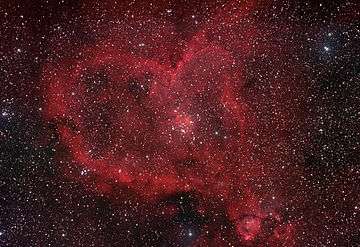HD 15558
HD 15558 (HIP 11832) is a massive O-type multiple star system in the constellation of Cassiopeia. It is located in the Heart Nebula in open cluster IC 1805. The primary is a very massive star with 152 M☉ and 660,000 L☉.
Physical characteristics
HD 15558 A is a spectroscopic binary system containing at least two massive luminous class O stars. The primary is an O4.5 giant star with a surface temperature over 46,800 K. It has a mass of 152 M☉ and a luminosity of 660,000 L☉. The star loses 1.5×10−5 M☉ per year.[7] The secondary is an O7V star. It has a mass of 46 M☉. The primary may itself be a double star, suggested by the improbably large mass found from the binary orbit when compared to the other stellar parameters.[4]
The Washington Double Star Catalog lists 11 companions with one arc minute of HD 15558 A, all fainter than 10th magnitude. In addition, it lists component E just over one arc minute away; it is another hot massive star, the 9th magnitude BD+60°501 with a spectral type of O7 V(n)((f))z.[3][8]
See also
References
- 1 2 3 4 5 Van Leeuwen, F. (2007). "F. Validation of the new Hipparcos reduction". Astronomy & Astrophysics. 474 (2): 653. arXiv:0708.1752
 . Bibcode:2007A&A...474..653V. doi:10.1051/0004-6361:20078357.
. Bibcode:2007A&A...474..653V. doi:10.1051/0004-6361:20078357. - 1 2 3 4 5 6 Ducati, J. R. (2002). "VizieR Online Data Catalog: Catalogue of Stellar Photometry in Johnson's 11-color system.". CDS/ADC Collection of Electronic Catalogues. 2237. Bibcode:2002yCat.2237....0D.
- 1 2 Sota, A.; Mainz Apellantiz, J.; Morrell, N.L; Barba, R.H; Walborn, N.R; et al. (2014). "The Galactic O-star spectroscopic survey (GOSSS). II. Bright southern stars.". Astronomy & Astrophysics. 563.
- 1 2 3 4 5 6 7 8 9 10 11 12 13 De Becker, M.; Rauw, G.; Manfroid, J.; Eenens, P. (2006). "Early-type stars in the young open cluster IC 1805. II. The probably single stars HD 15570 and HD 15629, and the massive binary/triple system HD 15558". Astronomy & Astrophysics. 456 (3): 1121. arXiv:astro-ph/0606379
 . Bibcode:2006A&A...456.1121D. doi:10.1051/0004-6361:20065300.
. Bibcode:2006A&A...456.1121D. doi:10.1051/0004-6361:20065300. - ↑ Pourbaix, D.; Tokovinin, A. A.; Batten, A. H.; Fekel, F. C.; Hartkopf, W. I.; et al. (2004). "SB9: The ninth catalogue of spectroscopic binary orbits". Astronomy & Astrophysics. 424 (2): 727. arXiv:astro-ph/0406573
 . Bibcode:2004A&A...424..727P. doi:10.1051/0004-6361:20041213.
. Bibcode:2004A&A...424..727P. doi:10.1051/0004-6361:20041213. - 1 2 3 4 Hillwig, T. C.; Gies, D. R.; Huang, W.; McSwain, M. V.; Wingert, D. W. (2006). "Binary and Multiple O-Type Stars in the Cassiopeia OB6 Association". The Astrophysical Journal. 639 (2): 1069. arXiv:astro-ph/0512407
 . Bibcode:2006ApJ...639.1069H. doi:10.1086/499771.
. Bibcode:2006ApJ...639.1069H. doi:10.1086/499771. - 1 2 Garmany, C. D.; Massey, P. (1981). "HD 15558 - an extremely luminous O-type binary star". Publications of the Astronomical Society of the Pacific. 93: 500. Bibcode:1981PASP...93..500G. doi:10.1086/130866.
- ↑ Mason, Brian D.; Wycoff, Gary L.; Hartkopf, William I.; Douglass, Geoffrey G.; Worley, Charles E. (2001). "The 2001 US Naval Observatory Double Star CD-ROM. I. The Washington Double Star Catalog". The Astronomical Journal. 122 (6): 3466. Bibcode:2001AJ....122.3466M. doi:10.1086/323920.
Coordinates: ![]() 02h 32m 42.54s, 61° 27′ 21.58″
02h 32m 42.54s, 61° 27′ 21.58″
